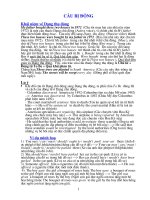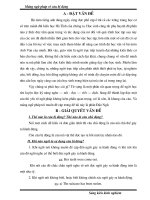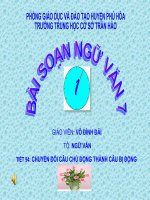Cấu trúc câu bị động
Bạn đang xem bản rút gọn của tài liệu. Xem và tải ngay bản đầy đủ của tài liệu tại đây (72.43 KB, 8 trang )
Cấu trúc câu bị động
Công thức chung
S+BE+V past participle(P2)
Điều kiện để có thể biến đổi 1 câu từ chủ động thành bị động:
- V trong câu chủ động phải là Transitive Verb (Ngoại động từ: đòi hỏi có O theo sau)
- Các O (trực tiếp, gián tiếp) phải được nêu rõ ràng
Quy tắc:
Khi biến đổi 1 câu từ chủ động sang bị động ta làm theo các bước sau:
a. Xác định S, V, O và thì của V trong câu chủ động.
b. Lấy O trong câu chủ động làm S của câu bị động.
Lấy S trong câu chủ động làm O và đặt sau By trong câu bị động.
c. Biến đổi V chính trong câu chủ động thành P2 (Past Participle) trong câu bị động.
d. Thêm To be vào trước P2 trong câu bị động (To be phải chia theo thời của V chính
trong câu
chủ động và chia theo số của S trong câu bị động).
Bảng công thức các thì ở thể bị động:
Tense
Simple Present
Active
S+V+O
Passive
S + be + P2 + by + O
Present Continuous S + am/is/are + V-ing + O
S + am/is/are + being + P2 + by + O
Present Perfect
S + has/have + P2 + O
S + has/have + been + P2 + by + O
Simple Past
S + V-ed + O
S + was/were + P2 + by + O
Past Continuous
S + was/were + V-ing + O
S + was/were + being + P2 + by + O
Past Perfect
S + had + P2 + O
S + had + been + P2 + by + O
Simple Future
S + will/shall + V + O
S + will + be + P2 + by + O
Future Perfect
S + will/shall + have + P2 + O
S + will + have + been + P2 + by + O
Be + going to
Model Verbs
S + am/is/are + going to + V +
S + am/is/are + going to + be + P2 + by + O
O
S + model verb + V + O
S + model verb + be + P2 + by + O
S + modal Verb + have +P2
S + modal Verb + have been +P2
CÁC TRƯỜNG HỢP ĐẶC BIỆT:
1/ It's your duty to+Vinf
-->bị động: You're supposed to+Vinf
VD: It's your duty to make tea today. >> You are supposed to make tea today.
2/ It's impossible to+Vinf
-->bị động: S + can't + be + P2
VD: It's impossible to solve this problem. >> This problem can't be solve.
3/ It's necessary to + Vinf
--> bị động: S + should/ must + be +P2
VD: It's necessary for you to type this letter. >> This letter should/ must be typed by you.
4/ Mệnh lệnh thức + Object.
--> bị động: S + should/must + be +P2.
VD: Turn on the lights! >> The lights should be turned on.
BỊ ĐỘNG CỦA CẤU TRÚC " NHỜ AI LÀM GÌ"
Chủ động
Have + sb + V
Get + sb + to V
Bị động
Have + st + P2
Get + st + P2
VD:
I have my father repair my bike. >> I have my bike repaired by my father.
I get my father to wash my car >> I get my car washed by my father
BỊ ĐỘNG CỦA ĐỘNG TỪ ĐI SAU NÓ LÀ MỘT ĐỘNG TỪ Ở DẠNG VING
Các động từ đó như : love, like, dislike, enjoy, fancy, hate, imagine, regret, mind, admit,
involve, deny, avoid....etc
>> Chủ động: S + V + sb Ving
Bị động: S + V + sb/st + being + P2
VD: I like you wearing this dress.
>> I like this dress being worn by you.
BỊ ĐỘNG CỦA ĐỘNG TỪ MAKE/ LET
MAKE
Công thức chủ động : S + make + sb+ Vinf --> Bị động: S +be+ made + to + Vinf
VD: They make me make tea >> I am made to make tea.
LET
Công thức chủ động: S + let + sb + Vinf --> Bị động: let + sb/st + be P2 hoặc be
allowed to Vinf
VD:
My parents never let me do anything by myself.
→ My parents never let anything be done by myself or I'm never allowed to do anything by
myself by my parents.
They don’t let us beat their dog.
→They don’t let their dog be beaten or We are not allowed to beat their dog.
BỊ ĐỘNG CỦA CÁC ĐỘNG TỪ TRI GIÁC( Vp --- verb of perception: see, watch, notice,
hear, look…)
1/ Cấu trúc chủ động: S + Vp + sb + Ving
>> Bị động: S + be + P2(of Vp) + Ving
(Ai đó chứng kiến người khác làm gì và chỉ thấy 1 phần của hành động hoặc 1 hành động đang
diễn ra bị 1 hành động khác xen vào)
VD: We saw her overhearing us >> She was seen overhearing us.
2/ Cấu trúc 2: S + Vp + sb + V
>> Bị động: S + be + P2(of Vp) + to +Vinf
(Ai đó chứng kiến người khác làm gì từ đầu đến cuối)
* NOTE: riêng các động từ : feel, find, catch thì chỉ sử dụng công thức 1.
BỊ ĐỘNG KÉP
1/ Khi main verb ở thời HIỆN TẠI
Công thức:
People/they + think/say/suppose/believe/consider/report.....+ that + clause.
>> Bị động:
a/ It's + thought/said/ supposed/believed/considered/reported...+ that + clause
( trong đó clause = S + Vinf + O)
b/ Động từ trong clause để ở thì HTDG hoặc TLĐ
S + am/is/are + thought/ said/supposed... + to + Vinf
VD: People say that he is a good doctor.
>> It's said that he is a good doctor.
He is said to be a good doctor.
c/ Động từ trong clause để ở thời QKDG hoặc HTHT.
S + am/is/are + thought/ said/ supposed... + to + have + P2.
VD: People think he stole my car.
>> It's thought he stole my car.
He is thought to have stolen my car.
2/ Khi main verb ở thời QUÁ KHỨ.
Công thức:
People/they + thought/said/supposed...+ that + clause.
>>Bị động:
a/ It was + thought/ said/ supposed...+ that + clause.
b/ Động từ trong clause để ở thì QKĐ:
S + was/were + thought/ said/ supposed... + to + Vinf.
VD: People said that he is a good doctor.
>> It was said that he is a good doctor.
He was said to be a good doctor.
c/ Động từ trong clause ở thì QKHT
S + was/were + thought/ said/ supposed... + to + have + P2.
VD: They thought he was one of famous singers.
>> It was thought he was one of famous singers. He was thought to be one of famous singers.
BỊ ĐỘNG CỦA 7 ĐỘNG TỪ ĐẶC BIỆT
Các động từ : suggest, require, request, order, demand, insist(on), recommend.
Công thức:
S + suggest/ recommend/ order/ require... + that + clause.
( trong đó clause = S + Vinf + O)
>> Bị động:
It + was/ will be/ has been/ is... + P2 (of 7 verbs) + that + st + be + P2.
( trong đó "be" là không đổi vì động từ trong clause ở câu chủ động ở dạng Vinf)
VD: He suggested that she buy a new car. >> It was suggessted that a new car be bought.
BỊ ĐỘNG CỦA CẤU TRÚC CHỦ NGỮ GIẢ " IT".
Công thức:
It + be + adj + for sb + to do st.
>>Bị động:
It + be + adj + for st + to be done.
VD: It is difficult for me to finish this test in one hour >> It is difficult for this test to be finished
in one hour.
BỊ ĐỘNG TRONG TRƯỜNG HỢP 2 TÂN NGỮ
Trong đó : Oi = Indirect Object.
Od = Direct Object.
Công thức:
S + V + Oi + Od
>>Bị động:
1/ Oi + be + P2( of V) + Od.
2/ Od + be + P2( of V) + to Oi.
( riêng động từ " buy" dùng giới từ " for" ).
VD: My friend gave me a present on my birthday.
>> A present was given to me by my friend on my birthday.
I was given a present on my birthday by my friend.
Cấu trúc câu bị động với các thì trong tiếng anh
Các thì
1. Hiện
đơn
Chủ động
tại
S + V(s/es) + O
Ví dụ:
Bị động
S+ is/am/are + VpII + (by + O)
Ví dụ:
- Mary studies English every day. - English is studied by Mary everyday.
2. Hiện tại tiếp
diễn
S + is/am/are + V-ing + O
Ví dụ:
S + is/am/are + being + VpII+ (by +
O)
Ví dụ:
- He is planting some trees now. - Some trees are being planted (by
him) now.
3. Quá
đơn
4. Quá
tiếp diễn
khứ
khứ
S + V-ed + O
S + was/were + VpII + (by + O)
Ví dụ:
Ví dụ:
- She wrote a letter yesterday.
- A letter was written (by her)
yesterday.
S + was/were + V-ing + O
S + was/were +being + VpII + (by +
O)
Ví dụ:
Ví dụ:
- They were buying a car at 9
am yesterday.
- A car was being bought at 9 am
yesterday.
5. Hiện tại
hoàn thành
S + have/ has + VpII + O
Ví dụ:
S + have/ has + been + VpII + (by
+ O)
Ví dụ:
- My parents have given me a
new bike on my birthday.
- A new bike has been given to me by
my parents on my birthday.
6. Hiện tại S + have/ has + been + V-ing + S + have/ has + been + being
hoàn
thành
O
+VpII+(by + O)
tiếp diễn
Ví dụ:
Ví dụ:
- John has been repairing this
car for 2 hours.
7. Quá khứ
hoàn thành
S + had + VpII + O
- This car has been being repaired by
John for 2 hours.
S + had + been + VpII + (by O)
Ví dụ:
Ví dụ:
- He had finished his report- His report had been finished before
before 10 p.m yesterday.
10 p.m yesterday.
8. Quá khứ
hoàn
thành
tiếp diễn
S + had + been + V-ing + O
Ví dụ:
S + had + been + being + VpII +
(by + O)
Ví dụ:
- The essay had been being typed for
- I had been typing the essay for
3 hours before you came yesterday.
3 hours before you came
yesterday.
9. Tương lai
đơn
S + will + V(nguyên thể) + O
Ví dụ:
S + will + be + VpII + (by O)
Ví dụ:
- She will do a lot of things - A lot of things will be done
tomorrow.
tomorrow.
10. Tương lai
tiếp diễn
S + will + be +V-ing + O
Ví dụ:
S + will + be + being + VpII + (by
O)
Ví dụ:
- She will be taking care of her
children at this time tomorrow - Her children will be being taken
care of at this time tomorrow.
11. Tương lai
hoàn thành
S + will + have + VpII + O
Ví dụ:
S + will + have + been + VpII + (by
O)
Ví dụ:
- She will have finished her
studying by the end of this year. - Her studying will have been finished
by the end of this year.
12. Tương lai S + will + have + been + V-ing
S + will + have +been + being +
hoàn
thành
tiếp diễn
+O
Ví dụ:
VpII + (by O)
Ví dụ:
- I will have been teaching - English will have been being taught
English for 5 years by nextby me for 5 years by next week.
week.


![Ph]ơng pháp rèn luyện câu chủ động sang câu bị động](https://media.store123doc.com/images/document/13/ly/kf/medium_kfs1373449372.jpg)






